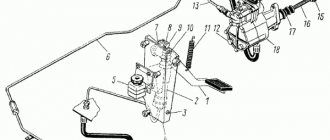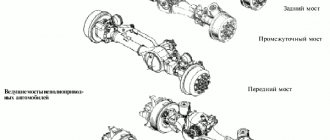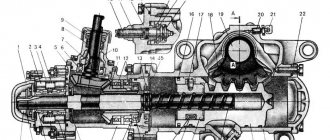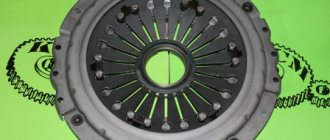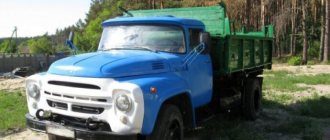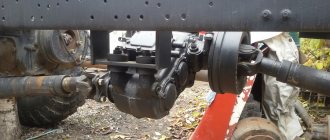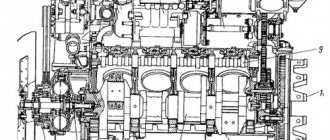Possible malfunctions of drive axle mechanisms
Signs of a malfunction of the drive axle mechanisms are increased noise, continuous knocking or “howling” of the main gear when the vehicle is moving. There may also be oil leakage in the crankcase connectors and through the seals.
When the vehicle is moving in various modes, serviceable main gears should operate almost silently. The oil temperature in the crankcase should not exceed the ambient temperature by more than 60-70 C. The appearance of noise during the operation of the main gear usually indicates a malfunction of the bevel gears due to wear or loosening of the bearings, as well as the appearance of excessively large lateral clearance between the teeth.
One of the reasons for increased noise when driving is a lack of oil in the main gear housing. Noise when cornering often indicates a problem with the differential. Continuous knocking noises in the final drive are caused by chipped or chipped gear teeth or damaged bearings. In the front axle of a car, this phenomenon may be associated with the destruction of parts of the cam cardan joint of the front wheel drive. The continuous “howling” of the main gear when the car is moving at high speeds is usually associated with severe wear of gears, bearings, or a lack of oil in the crankcase.
A lubricant leak occurs when the working edges of the oil seals are worn and damaged, the bearing caps are loosened, the oil level in the axle crankcase is high, the ventilation caps (breathers) or pipelines of the crankcase sealing system are clogged.
Main gear maintenance
Maintenance of the final drive and differential includes maintaining the required oil level in the crankcases, periodically changing the oil, checking the connections and fastenings of the crankcases and their covers, as well as adjusting the bearings and gear mesh. Periodically wash the ventilation caps (breathers) and pipelines of the main gear sealing system. When checking the connections of the drive axles of a KamAZ-5320 vehicle, it is necessary that the tightening torques for the nuts of the studs securing the main gear housing to the drive axle housing be 160-180 N
18 pages, 8554 words
UAZ car transmission
... box, but the total volume of oil ensures normal operation of both units. CARDAN TRANSMISSION., Rear propeller shaft, DRIVING AXLES. The driving axles of the car through the drive wheels perceive... tightening all threaded connections, checking clearances in the pivot joint, adjusting bearings, gear engagement, wheel alignment. 2. Possible malfunctions, Possible clutch malfunctions...
- m (16-18 kgf
- m), for bolts securing the center differential housing to the main gear housing 36—50 N
- m (3.6-5 kgf
- m).
When checking the connections of the drive axles of a car, it is necessary that the tightening torques of the bolts securing the main gear housing to the drive axle housing are 120-150 N for bolts M 14
- m (12-15 kgf
- m), for bolts M 18 190–230 N–m (19–23 kgf
- m).
The nut of the main gear housing mounting stud is tightened to a torque of 90-100 N - m (9-10 kgf
- m), and the nuts securing the flanges of the main gear housing with a torque of 250 N
- m (25 kgf
- m).
The oil level is checked using the control hole. -When ; If necessary, top up the oil using the same procedure; hole. When changing, the used oil is drained after preheating the main gear through the drain holes in the axle housing. For the KamAZ-5320 vehicle, it is necessary to additionally drain the oil from the center differential housing. Filling of new oil into the main gear housing and into the center differential housing of the KamAZ-5320 vehicle is carried out through the filler holes until oil appears in the control hole. Fills into the main gear housing 3.4 liters and into the center differential housing 0.5 liters. Transmission oil TSp-15K, substitute - TSp-15V,
1. Titunin B.A. Repair of KamAZ vehicles. – 2nd ed., revised. and additional – M.: Agropromizdat, 1991. – 320 p., ill.
2. Buralev Yu.V. and others. Design, maintenance and repair of KamAZ vehicles: Textbook for environments. prof.-techn. schools / Yu.V. Buralev, O.A. Mortirov, E.V. Kletennikov. – M.: Higher. school, 1979. – 256 p.
3. Barun V.N., Azamatov R.A., Mashkov E.A. and others. KamAZ vehicles: Maintenance and repair. – 2nd ed., revised. and additional – M.: Transport, 1988. – 325 p., ill. 25.
4. Repair and maintenance manual for KamAZ-5320, -53211, -53212, -53213, -5410, -54112, -55111, -55102 vehicles. – M.: Third Rome, 2000. – 240 pp., ill. 15.
Project of a vehicle fleet for vehicle maintenance
Operation of double main gears KamAZ-5320
Organization and technology of carrying out repair work on the PAZ-3205 bus
Slitting machine with a capacity of 350 t/day
Design development and manufacturing technology for a duplicate control device for a training vehicle
Development of a large service station for diagnostics, repair, and maintenance of passenger cars
Improving the organization and technology of maintenance and current repairs of trucks
Truck tractor with a 4*2 wheel arrangement with the development of a limited slip differential
Study of the technical operation features of the chassis of Toyota vehicles
Development of car service
Project of a service station with the development of a site for repairing the chassis of passenger cars for the state institution sanatorium "Primorye" st. Okeanskaya, Vladivostok
Crankshaft
Design and principle of operation of the ZIL-130 car
Bearing box design
Complete answers to tickets for auto engineering (exam 2002)
12 pp., 5978 words
Car Design Basics
... to increase the speed of air movement through the carburetor and increase the vacuum at the nozzle. design car carburetor drive axle Behind the diffuser in the air pipe there is a throttle valve 4, ... consisting of an exhaust pipe 11, a pipe 7 and a muffler 5 for exhaust noise. The design of the exhaust system is similar for all mixture formation systems. Combustible mixture. Fuel for education...
Drive of the conveyor belt, consisting of an electric motor, a two-stage cylindrical gearbox and couplings
Engine ZIL-130
Examples of similar educational works
Repair of the rear axle gearbox of a ZIL car
... that the rear axle gearboxes experience heavy dynamic loads. As a result, the problem of their frequent repairs and adjustments is urgent. 1. Calculation part 1.1 Design of repair technology repair car gearbox axle Removal...
Repair of the rear axle gearbox of the GAZ 3307 car, accessories and tools
... assembled, connect them to the rear axle housing and complete the complete assembly. Analysis ... and foreign automobile production. Purposeful work of the manufacturer to improve... gas, argon-arc, carbon dioxide and other types of welding. ...
Features of technical repair of the front axle of a GAZ car
... in the event of malfunctions that make further operation of the vehicle impossible or unprofitable. Work on the current repair of the front axle of the GAZ-31029 vehicle will be carried out at the TR post, where...
Diagnosis of the front axle of cars
... front axle of the MAZ-5429 car. 1 . Characteristics of the design object 1.1 General characteristics of the design object The ATP production is entrusted with performing maintenance and repair... of vehicles undergoing maintenance and repair and improving the management process...
Design of a site for the repair of rear axle gearboxes of automobiles
... Ivanov I.L. Methodological development for the technical and economic assessment of theses. – Izhevsk 2002. 27. Popova G.N. Handbook...PROCESS 4.1. Methods for restoring the rear axle gear housing of cars 4.2. Description of the technological process...
1.5. Basic final drive adjustments
In the main gear, the tightening of the tapered bearings of the drive bevel gear (KAMAZ-5320), the bearings of the drive drive shaft, the tapered bearings of the intermediate shaft and the cross-axle differential housing are adjusted. The bearings in these units are adjusted with preload. When making adjustments, the preload must be checked very carefully to avoid malfunctions, since tightening the bearings too tightly leads to their overheating and failure.
The main gears also provide the ability to adjust the engagement of the bevel gears. However, it must be borne in mind that it is impractical to adjust the working pair during operation. It is carried out with a repair or new set of a pair of bevel gears when replacing a worn pair. Adjustments of bearings and bevel gear engagement are carried out with the main gear removed from the vehicle.
Adjustment of the bearings of the drive bevel gear of the main transmission of the middle drive axle of the KamAZ-5320 vehicle is carried out by selecting the required thickness of two adjusting washers (see Fig. 4.21), which are installed between the inner ring of the front bearing and the spacer sleeve. After installing the adjusting washers, the fastening nut is tightened to a torque of 240 Nm (24 kgfm).
When tightening, it is necessary to rotate the drive gear 20,
so that the rollers take the correct position in the bearing races
Then the locknut is tightened to a torque of 240–360 Nm (24–36 kgfm) and fixed. The amount of bearing preload is checked by the torque required to rotate the drive gear. When checking, the moment of resistance to turning the drive gear in the bearings should be 0.8-3.0 N-m (0.08-0.30 kgf-m).
The moment of resistance must be measured when the gear rotates smoothly in one direction and after at least five full revolutions. The bearings must be lubricated.
15 pages, 7414 words
Maintenance and repair of VAZ car gearbox (2)
…repair of highly qualified vehicles; comply with internal fire safety rules; When repairing equipment, apply the most appropriate and productive methods of work and modern methods of labor organization. 2. Second section 2.1 Maintenance of VAZ...
Adjustment of the bearings of the drive bevel gear of the main transmission of the rear drive axle of the KamAZ-5320 vehicle (see Fig. 4.22) is carried out by selecting the required thickness of the adjusting washers, which are installed between the inner race of the front bearing and the support washer. The moment of resistance to turning the drive gear shaft should be 0.8-3.0 Nm (0.08-0.30 kgf-m).
When checking this point, the bearing cup cover must be moved towards the flange so that the oil seal does not resist rotation. After the final selection of the adjusting washers, the universal joint flange nut is tightened to a torque of 240–360 Nm (24–36 kgfm) and secured with a cotter pin.
— Tapered roller bearings (see Fig. 4.21) of the intermediate shaft of the main drive of the KamAZ-5320 vehicle are adjusted by selecting the thickness of two adjusting washers, which are installed between the inner races of the bearings. The moment of resistance to turning the intermediate shaft in the bearings should be 2-4 Nm, as when adjusting the drive gear bearings.
Adjustment of the preload of the tapered roller bearings of the differential housing is carried out using nuts 8.
Prev: the tension is controlled by the amount of crankcase deformation when tightening the adjusting nuts.
When adjusting, pre-tighten the cover mounting bolts 22
to a torque of 100-120 Nm (10-12 kgf-cm).
Then, by tightening the adjusting nuts, the preload of the bearings is ensured such that the distance between the ends of the bearing caps increases by 0.1-0.15 mm. The distance is measured between the pads for the locking nuts of the differential bearings. In order for the rollers in the bearing races to occupy the correct position, the differential housing must be rotated several times during the adjustment process. When the required preload is achieved, the adjusting nuts are locked, and the bearing cap fastening bolts are finally tightened to a torque of 250-320 Nm (25-32 kgf-m) and also locked.
When adjusting the tapered roller bearings of the main gear and differentials of the drive axles of the Ural 4320 vehicle, the main gear with the differential and cardan flanges removed is installed in a device. All tapered roller bearings of the main drive are adjusted with preload, just like on the KamAZ-5320 vehicle. Bearing adjustment 12, 18
(see Fig. 4.24) of the drive through shaft is carried out by changing the thickness of the set of adjusting shims
11
and
16.
With correctly adjusted
bearings, the moment of resistance to rotation of the drive shaft should be 1-2 Nm (0.1-0.2 kgf-cm).
The bearing cap fastening bolts must be tightened to a torque of 60-80 Nm (6-8 kgf-m).
Bearing adjustment 6
The intermediate shaft is adjusted by changing the thickness of the set of shims
8
under the bearing cover. By sequentially removing the gaskets, the gap in the bearings b is selected, after which another gasket with a thickness of 0.1-0.15 mm is removed. The moment of resistance to turning the intermediate shaft should be equal to 0.4-0.8 Nm (0.04-0.08 kgf-m).
Removing the gaskets from under the bearing cap shifts the driven gear towards the drive gear and leads to a decrease in the lateral clearance in the mesh, so it is necessary to install the removed gaskets under the flange of the bearing cup 5
into the set of gaskets 7 and thereby restore the position of the driven bevel gear relative to the drive gear. Tighten the bearing cover bolts with a torque of 60-80 Nm (6-8 kgf-m).
13 pages, 6004 words
Purpose and characteristics of the vehicle lubrication system (using the example of KamAZ-5320)
... the operating principle of the KamAZ-5320 lubrication system The KamAZ-5320 combined lubrication system, with a “wet” sump. Oil under pressure is supplied to the main and connecting rod bearings of the crankshaft, to the bearings ... the higher the flash point, the less oil is burned in the engine and, therefore, the less carbon deposits are formed on the parts. Stability is the ability of an oil to retain its original...
After adjusting the bearings of the drive through and intermediate shafts, it is advisable to check the correct engagement of the bevel gears “on the paint”. The imprint on the driven gear tooth should be located closer to the narrow end of the tooth, but not reach the edge of the tooth by 2-5 mm. The length of the imprint should not be less than 0.45 times the length of the tooth. The lateral gap between the teeth at their widest part should be 0.1-0.4 mm. Bevel gear mesh adjustments should be made by a mechanic or an experienced driver.
When adjusting the differential housing bearings, tighten the bearing cap bolts to a torque of 150 Nm (15 kgfm), then tighten the nuts 24,
set zero clearance in bearings; After this, tighten the nuts by the amount of one groove. The deformation of the bearing supports in this case is 0.05–0.12 mm. After adjustment, it is necessary to tighten the bearing cap bolts to a torque of 250 Nm (25 kgfm).
KAMAZ center differential: its functions and malfunctions
The MOD is installed on the gearbox of the KAMAZ middle axle and is one of the units that receives a fairly large load, which often disables it. The center differential is one of the most fragile components of the KAMAZ vehicle transmission; it is assembled as part of the middle axle gearbox.
The task that the center differential performs is to improve the vehicle's handling.
How does this happen? If the MOD is turned off, rotation goes only to the rear axle, this allows you to save the resource of the middle axle gearbox. The load on the bridge is reduced, and accordingly the car becomes more economical.
If the MOD is turned on, it is blocked and the gearbox shafts of the drive axles are connected, which increases the vehicle's cross-country ability. This can help in difficult road conditions, such as ice.
Also, the ability to disable the middle axle using the MOD saves fuel. In rare cases, the middle axle gearbox may not be equipped with a MOD; for example, on all-wheel drive vehicles, reducing cross-country ability may not be necessary, so often there is no center differential.
Since the MOD completely absorbs all the torque and all the power of the engine, it is subject to quite serious loads. Very often the MOD fails due to the main driveshaft of the car, which is attached to it. For one reason or another, the main driveshaft may be unbalanced. And this imbalance places a harmful load on the center differential.
Center differential malfunctions
One of the main reasons for MOD failure is oil starvation. The MOD is located at the top of the middle gearbox. Due to the low oil level in the axle, it may not receive enough lubrication. This leads to increased wear and failure of the main gears, up to the breaking of the MOD in half.
Some of the MOD malfunctions can be determined independently. One of the main signs of a malfunctioning MOD is a play that appears on the MOD flange. Oil leaks also indicate that you need to pay attention to the operation of the MOD. If the MOD overheats without oil, the paint on it will burn.
reduktor67.ru
